At the start of the calendar year, Athletic Club decided to part ways with current SD Eibar head coach Gaizka Garitano after almost two-and-a-half years in charge.
Within 24 hours, former Valencia and Villarreal manager Marcelino Toral put pen to paper to become the newest man in the dugout of the San Mamés.
From the get-go, Marcelino had the team playing a very direct, transition-based style of football which was built around high-pressing and defensive solidity. Within two weeks of his arrival, the Basque club had won the Supercopa de España and the fans fell in love with the new manager.
This season, Athletic Club’s results have been inconsistent, with more than half of their games ending as draws, but Marcelino has ensured that his side have become the most prominent pressing team in La Liga. No team averages more pressures in the final third than the Bilbao-based club.
Their excellent organisation is an influential factor behind Athletic Club’s defensive record this season – the joint-best in the Primera División.
This article will be a tactical analysis of Athletic Club’s organisation in the press this season, completed in the form of a team scout report. The analysis will be particularly focused on Marcelino’s tactics in the high and mid-pressing phases.
Formation used
For those who have followed Marcelino’s career closely over the past decade, as well as the current tactical trends in La Liga, it will not come as much of a surprise that the Spanish coach opts to set his team up in a 4-4-2 defensive block.
In possession, this switches to more of a 4-2-2-2 with a box in midfield, but this analysis will strictly focus on their defensive structure.
The 4-4-2 is rigid and Marcelino deploys this against any and all opposition, regardless of the quality and tactical system they are facing. This has proven to be rather problematic against certain teams which will be analysed in further detail later.
Athletic Club have set up in the 4-4-2 in 94% of their games in all competitions this season. The only other system played by Marcelino was the 4-4-1-1 which is extremely similar, but one striker drops off and operates more as a ‘10’.
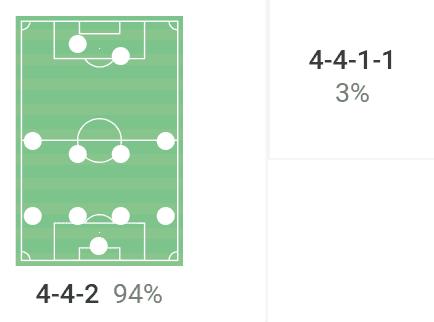
In the high block phase, this 4-4-2 can sometimes become a 4-1-3-2 as one defensive midfielder remains deeper to deal with the long balls and protect the backline by sweeping up any second balls from these direct passes by the opposition. This will be analysed later.
Initial pressing
The high-block phase occurs when the opposition are in their defensive third – or the final third for the defending team – and are trying to play out from the back. Athletic Club are the most-common pressers in La Liga in this defensive phase.
The Basque club are applying 43.8 pressures in the final third on average per 90 in the Spanish top-flight this season, which is more than any other team in the league. Getafe were the closest behind them with 39.3.
Marcelino’s team are allowing the opposition just 50.7% of the ball on average this season, the ninth-lowest in the league. Using these two statistics in correlation, one can see that Athletic Club are one of the highest-pressing teams in the country.
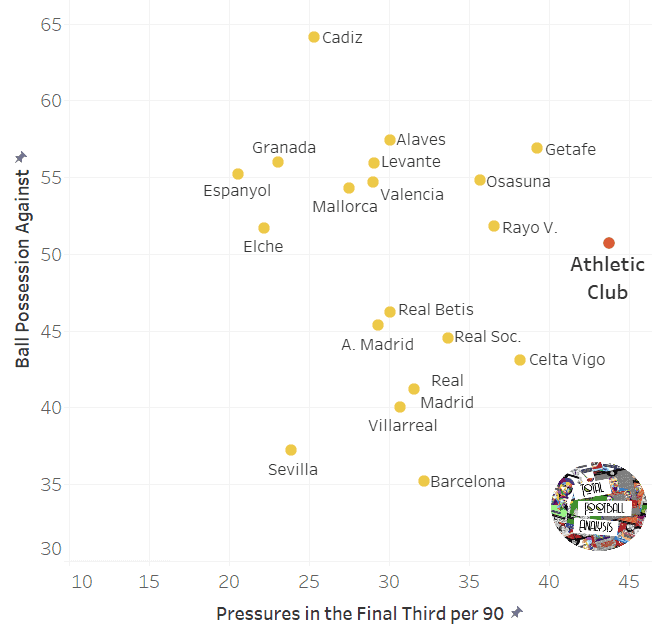
A key principle from Athletic Club is always to force the opposition to play into the wide areas which allows Marcelino’s side to set pressing traps to try and win back possession.
When the ball is in the central area as the opponent are trying to build their way out from the back, Athletic Club’s defensive shape resembles that of a 4-1-3-2.
Of course, in reality, one of the defensive midfield players sits back to protect the backline while his partner moves up higher to mark the opponent’s ball-near pivot players. The shape is a lopsided 4-4-2 in actuality but a 4-1-3-2 would be the most descriptive way to envision the shape.
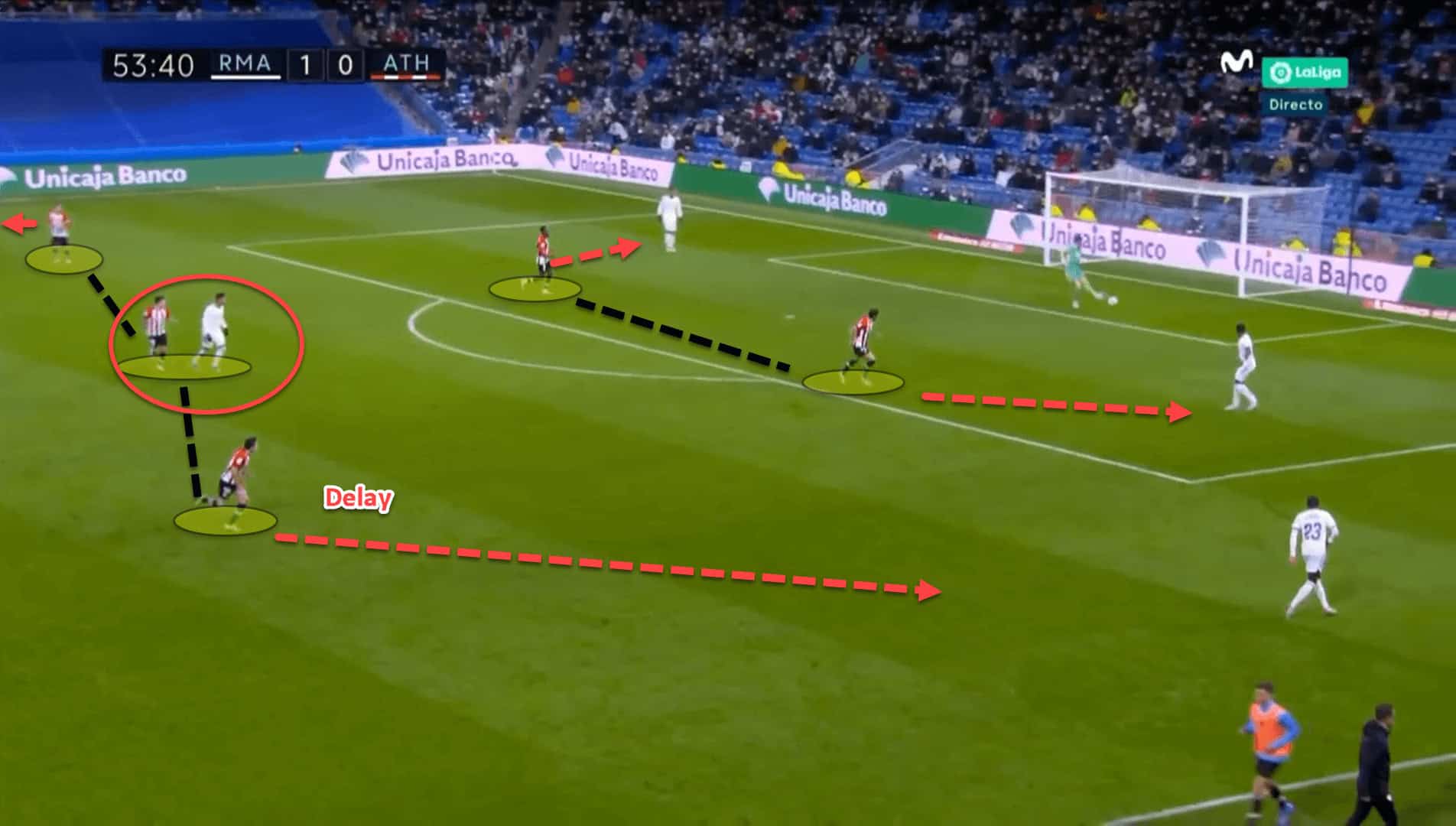
Here is this high-block shape against Real Madrid’s 4-3-3 while building out from the back. The first line of pressure is tasked with pressing the centre-backs and angling their pressure to force the attacking team to play out wide.
Unai Vencedor has pushed up onto Casemiro in this scenario too. As Los Blancos tend to play with just a single-pivot, it made his tactical role in the press simpler as he would have to man-mark just one player.
The role of the higher pivot player changes slightly when a second player drops into this area or if the opponents are playing with a double-pivot. Marcelino maintains this 4-1-3-2 shape, but the player is tasked with marking the nearest to the ball.
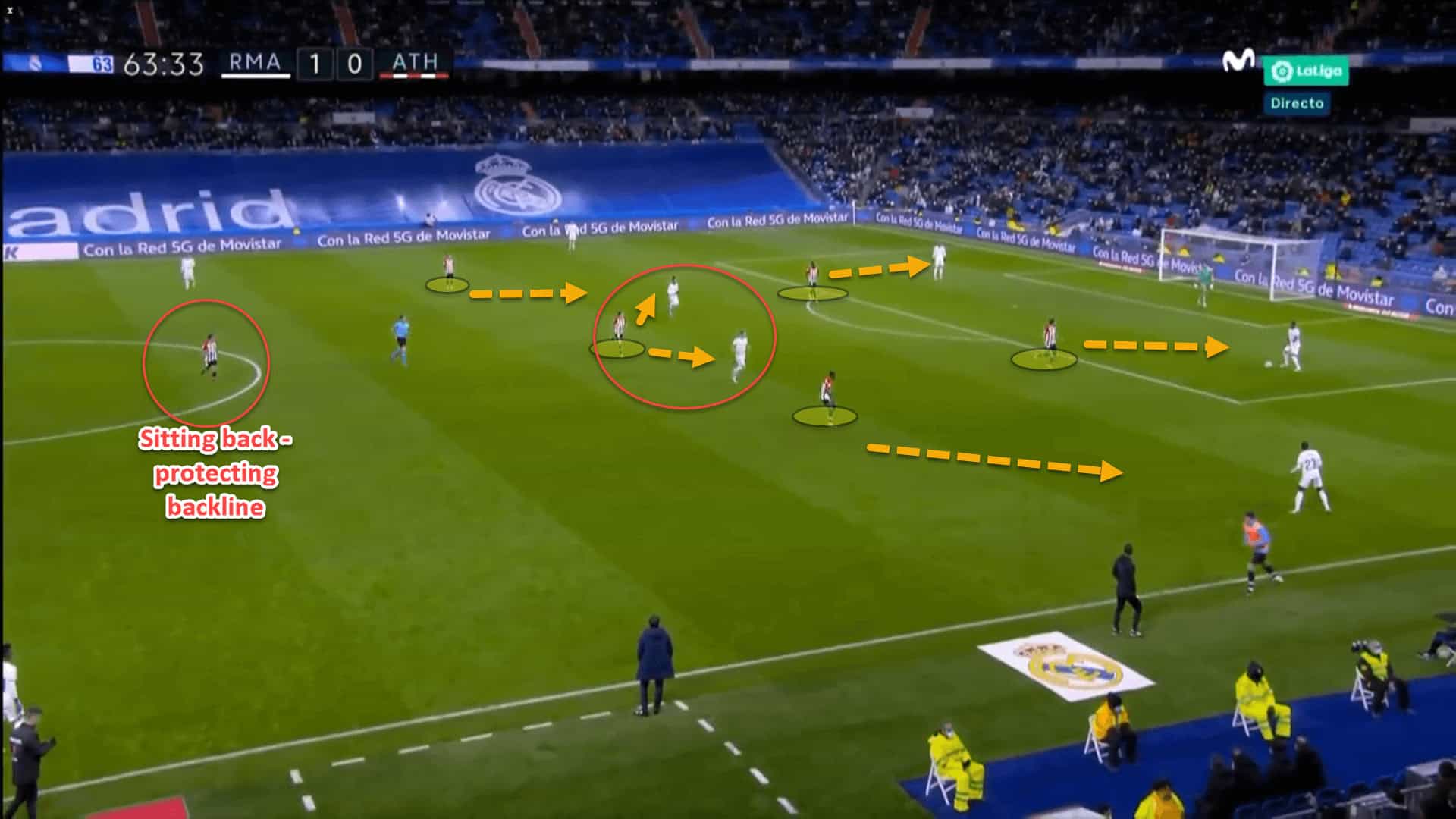
Here, Toni Kroos has dropped deep alongside Casemiro to provide another passing option for Real Madrid’s backline. As the ball moves to the left-back, Vencedor moves across to mark Kroos while the ball-far winger, Iker Muniain, drops onto Casemiro.
This leaves Athletic Club susceptible to switches of play as the ball-far winger is tucked in but allows them to cover all of the nearest passing lanes. Another example of this pressing structure against a double-pivot and a back four can be seen in the following images:
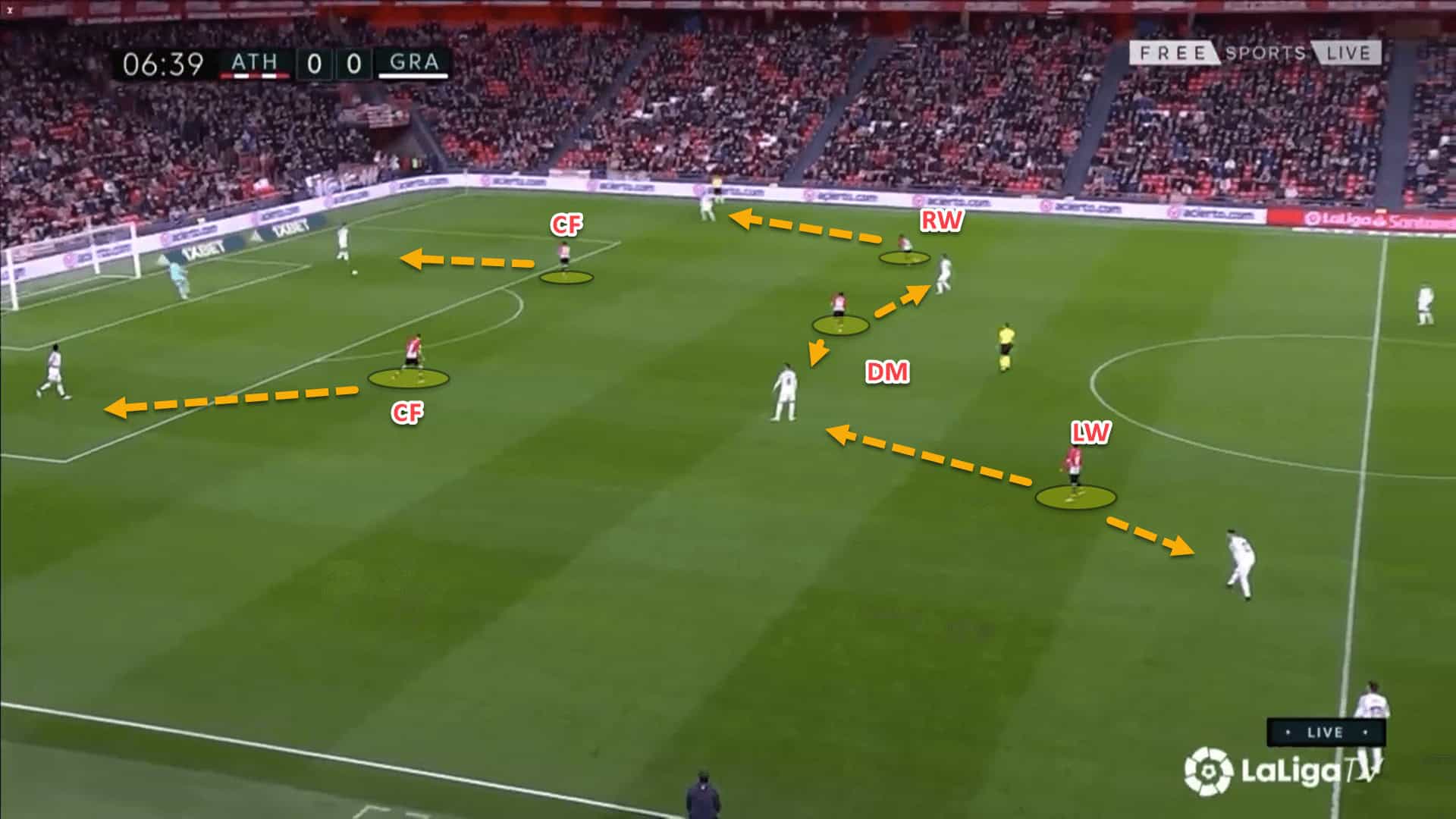
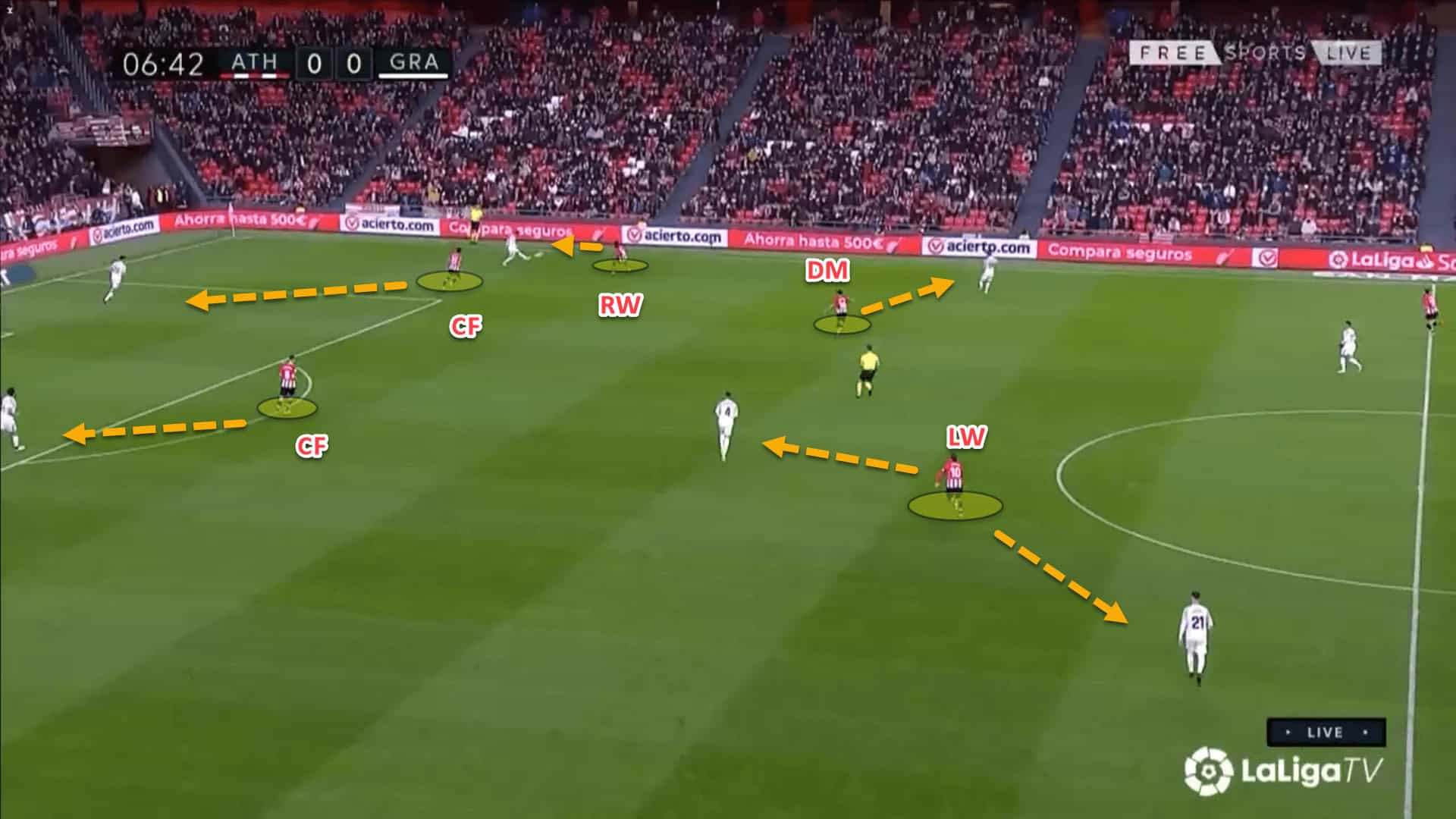
Meanwhile, the two wingers are instructed to press the fullbacks but delay their pressure until the pass is played out wide.
Regardless of who plays there, the wingers are so well-drilled under Marcelino at delaying their pressure. They sit compact and narrow alongside the higher pivot player and then pounce when the ball is moved out wide.
If they go too early, it will leave space centrally for the opponent to exploit. Since the objective is to allow the pass to the fullbacks anyway, leaving the lane open to these players makes sense.
As soon as the ball is moved out wide, Athletic Club’s players tightly mark the ball-near options and defend aggressively in order to force a turnover of possession, a backwards pass, or else a long ball up the pitch.
Closing down the nearest passing options is the priority though even if this is not a player’s original man.
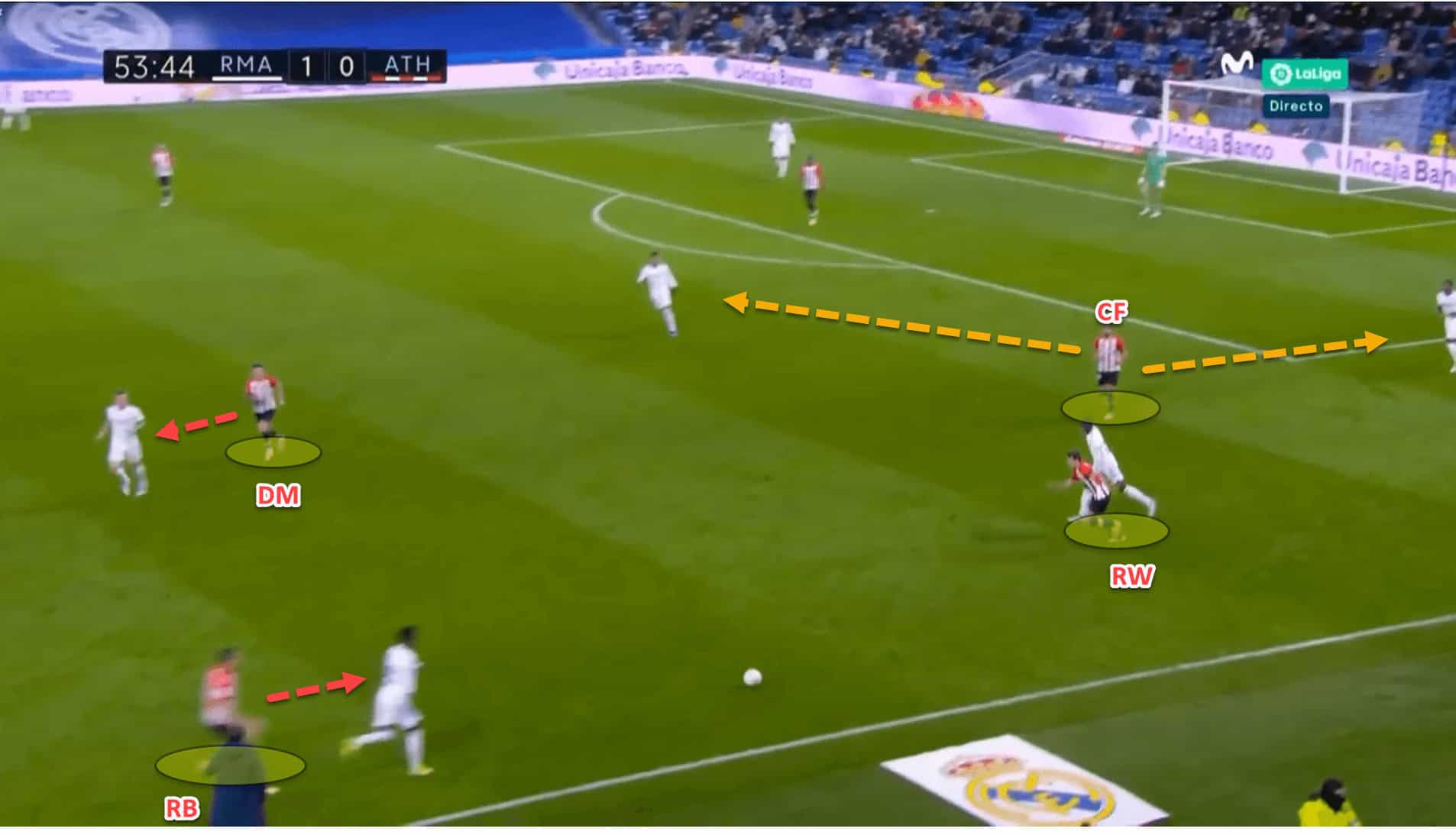
Here, Raúl García was originally pressing the centre-back but fails to drop off onto Casemiro to cut the passing lane into the Brazilian international when Real are playing out of Athletic Club’s pressure. This provides the Spanish giants with an easy route out. When a pressing trap is completed successfully, all of the passing lanes will be closed off and marked.
This also requires the fullback to track the winger into deeper areas. Often, if there is no inside passing option, a fullback in possession will play down the line to the winger that drops short to receive. The defending fullback needs to ensure that the opponent cannot play out of the pressing trap by using the winger as a free man.
Issues with the press
Pressing systems take different forms when playing against certain tactical systems. The approach a team takes while defending in a high-block against 4-3-3 might not alter too much when facing a 4-2-3-1 but may need adaptation against a system such as a 3-5-2.
Marcelino does not tend to adapt Athletic Club’s approach against back-three systems too much. Often, when a team faces a back three, one of the wide centre-backs will push out to the flanks to become a temporary fullback with the wingback pushing high on that same side.
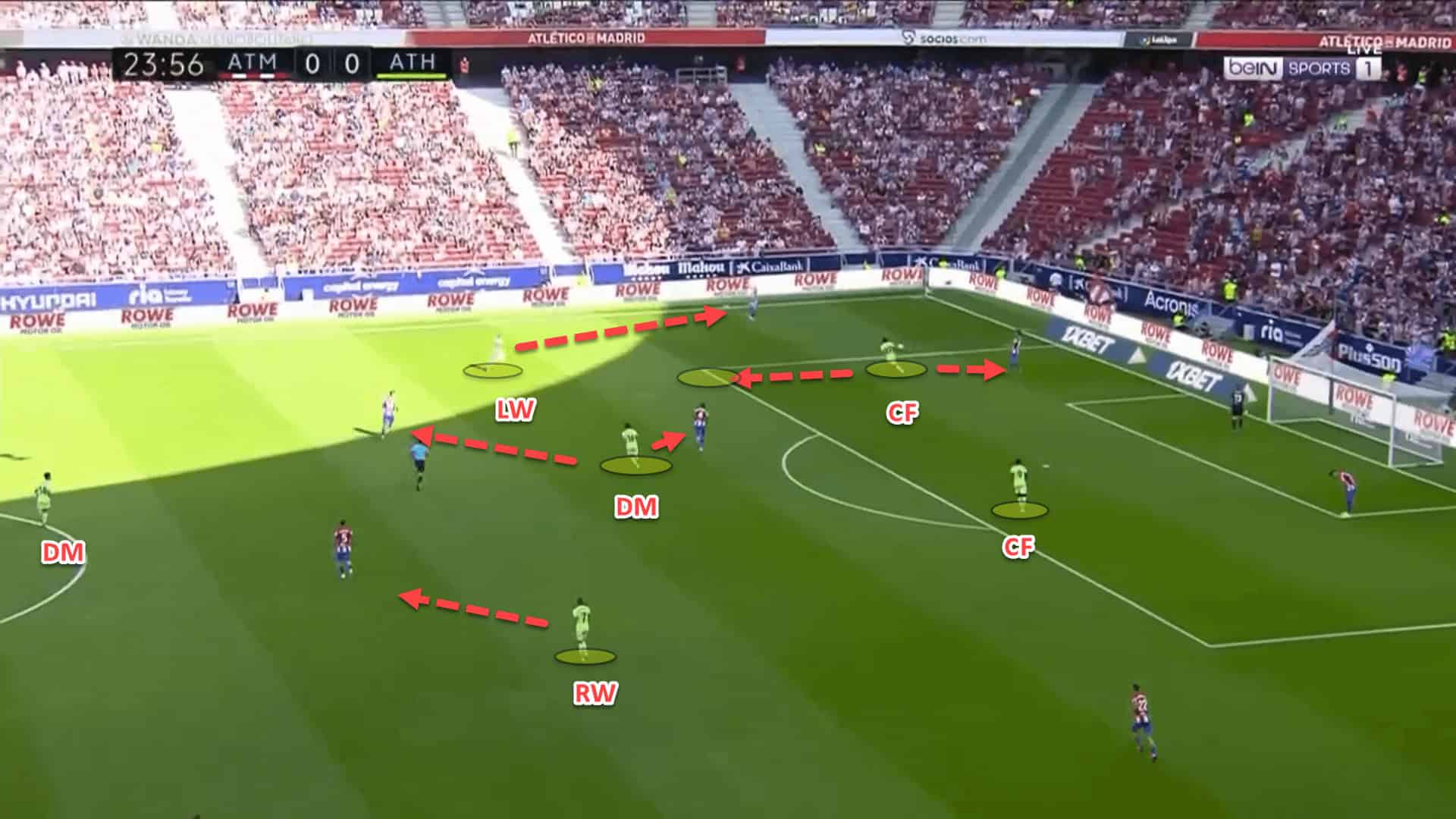
Again here, the 4-1-3-2 high-block can be seen being put into use against Atlético Madrid’s back three. Regardless, the right wingback for Los Colchoneros has dropped short with the left centre-back pushing wide to create a back four and so their shape resembles a 4-3-3 in this instance.
Nothing really has to change for Athletic Club in this phase. Again, the objective is to force the centre-backs and goalkeeper to play wide, delay pressure from the wingers, and ensure that all passing lanes are cut off when the ball is moved to the flanks in order to try and regain possession in a trap.
One would not be blamed for thinking that the issue with Athletic Club’s pressing comes from when they are tasked with pressing a back three. Nevertheless, this is simply not the case. The tactics and system do not need to change much at all, and the basic ideas are the same.
The issues with their press come in two different forms. Firstly, as stated earlier in this piece, Athletic Club leave themselves very exposed to switches of play.
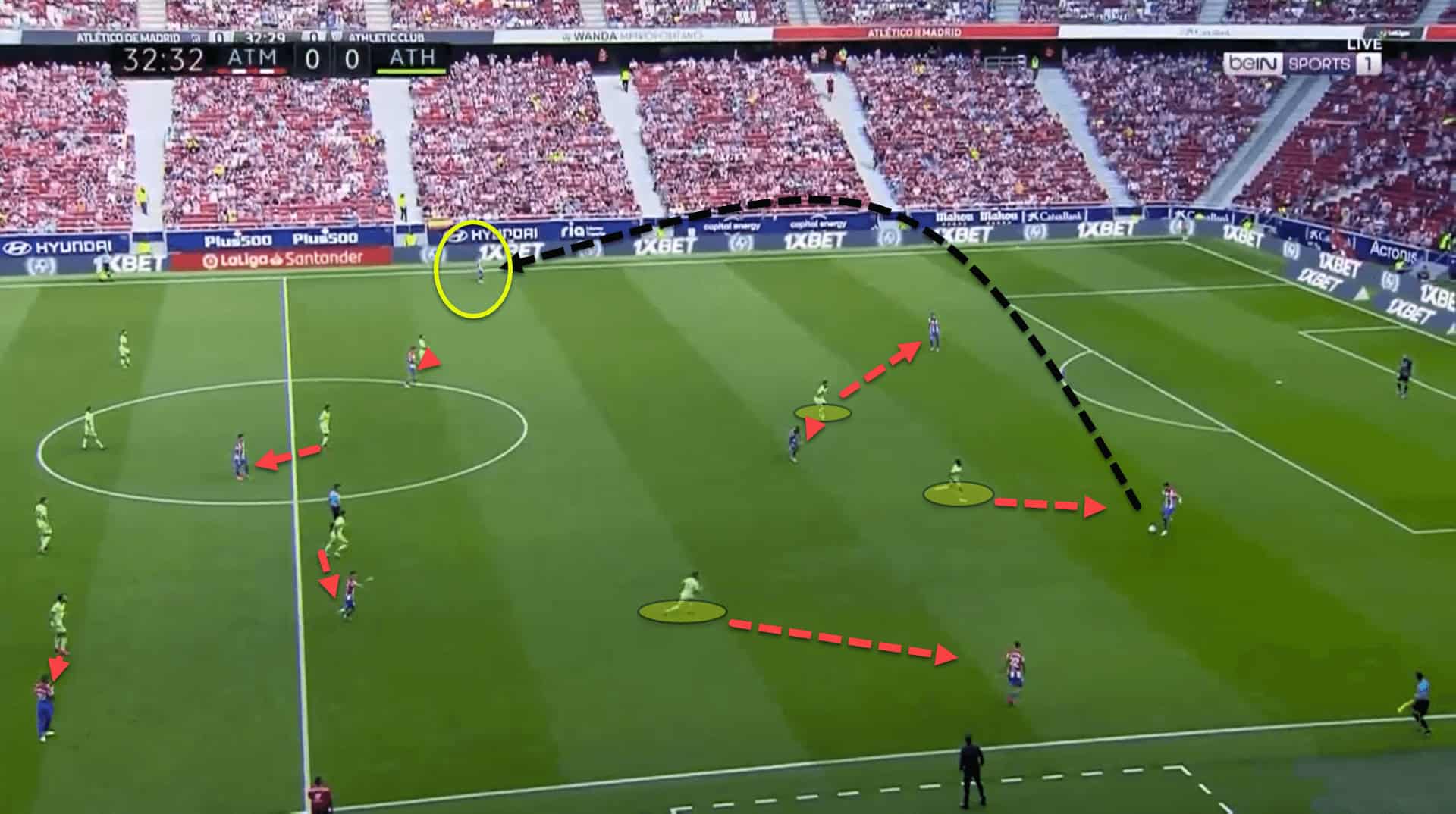
In this instance, Athletic Club have successfully forced Atlético Madrid to play out to the flank, where the pressing trap is initiated. Athletic Club shift their defensive block over to the ball-side in order to cover all the nearest passing options.
However, this leaves a plethora of space on the opposite wing for the team in possession to switch the ball to. Atlético’s centre-back doesn’t take up the option on this occasion, but the possibility is still there.
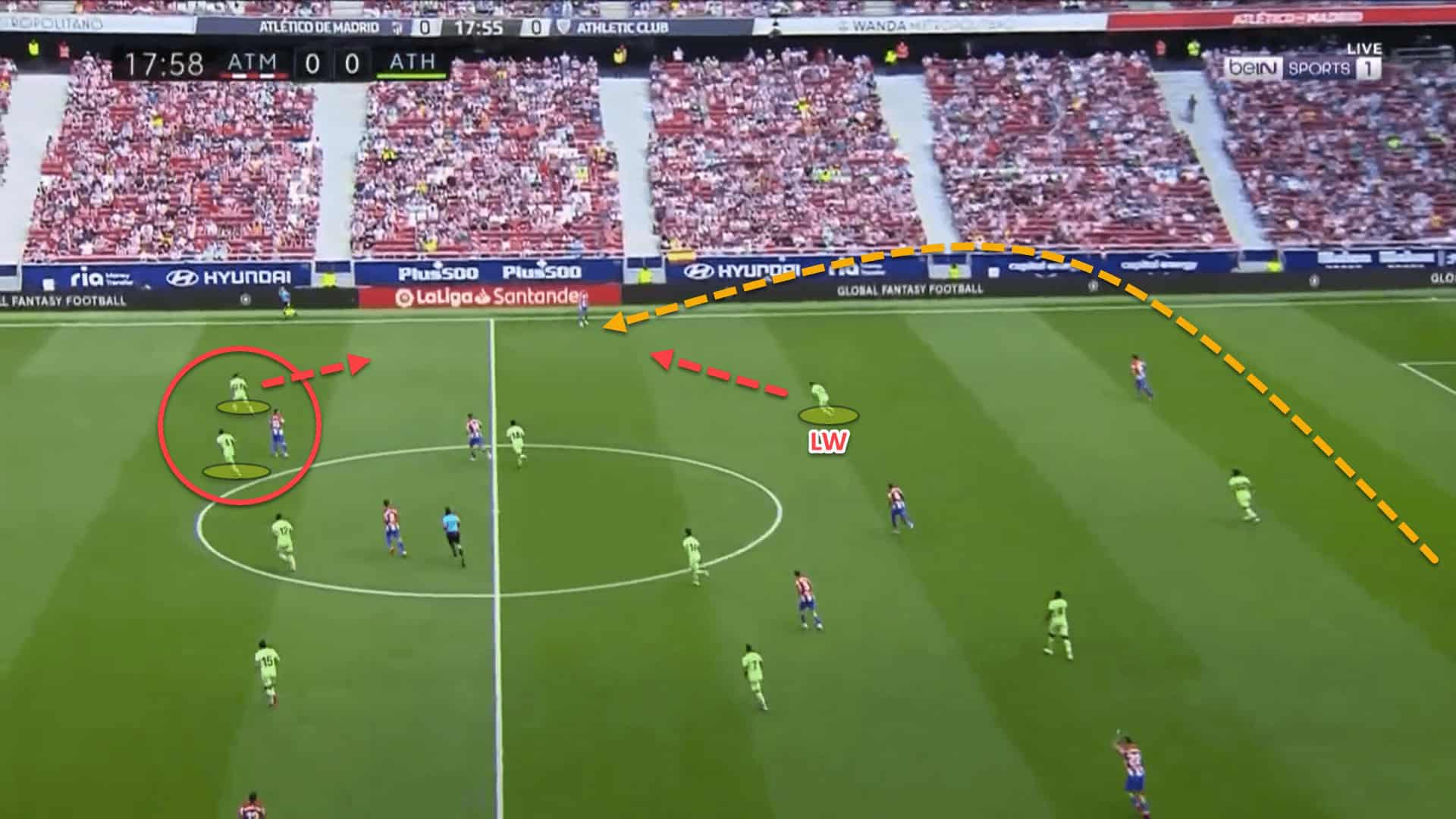
Here, Atlético did take up the option. When a switch of play occurs, it is generally up to the ball-near winger or fullback of any team to engage first. Nonetheless, in this example, because the left-winger had tucked to so far inside, he was unable to move out in time.
The fullback was also pinned back by Atlético’s forward and so the wingback that received the ball from the switch of play was able to carry the ball into a dangerous area before he was eventually closed down.
Another dysfunction of Athletic Club’s press is that the furthest pivot player can get easily overloaded if the press breaks down.
As stated numerous times, one pivot player remains deeper, in front of the backline in order to protect the backline from long balls and second balls. This player also plays a more zonal role, marking any of the opposition’s forward or midfielders that drop into this space.
However, an issue arises when more than one player overloads his zone while Athletic Club are pressing high.
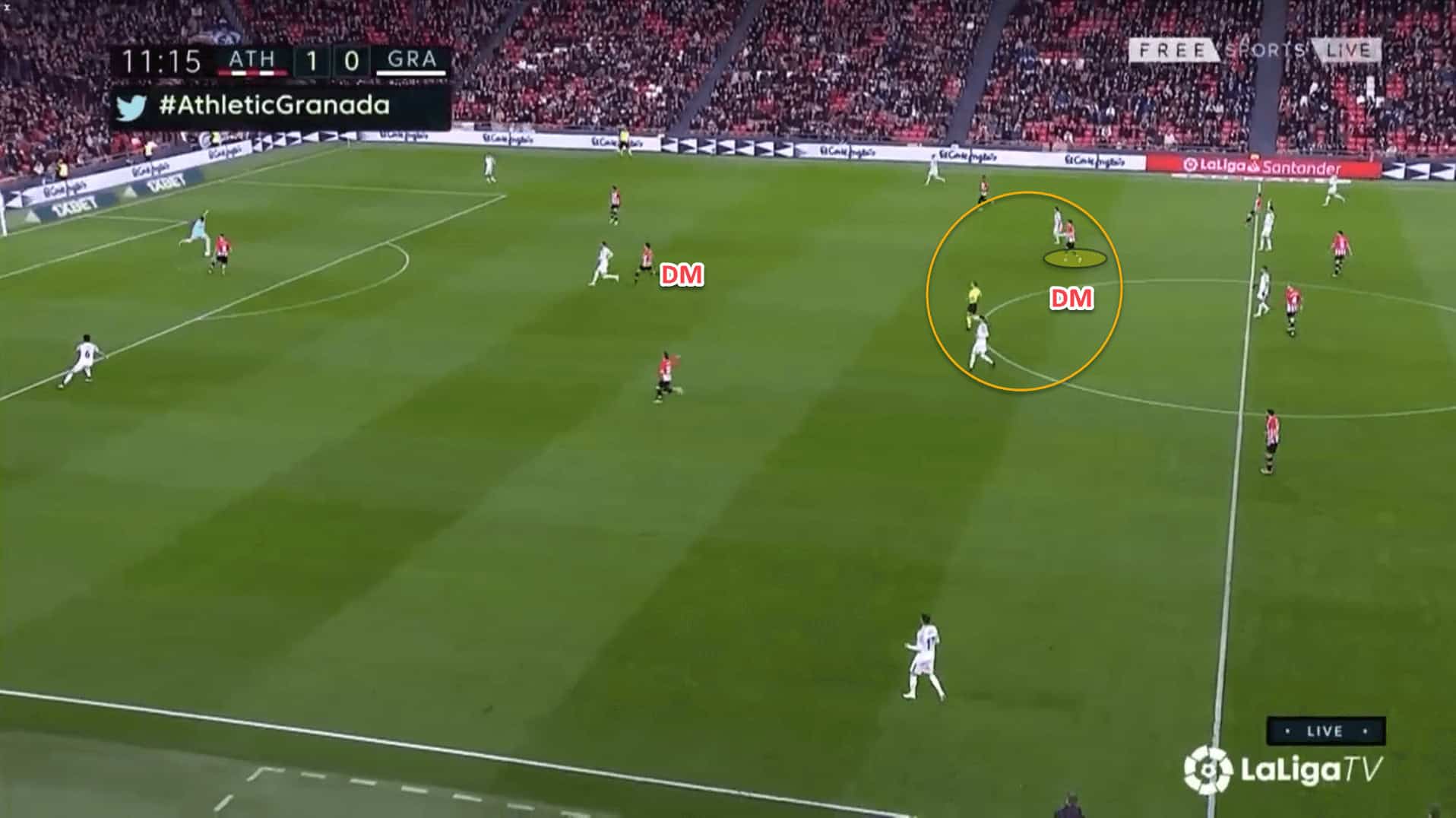
The job of the deepest pivot player becomes more difficult because he will essentially have to mark two separate players when Athletic Club are pressing high.
This is not so much of an issue if the press is applied correctly but can be problematic if the opponent breaks through the original pressure.
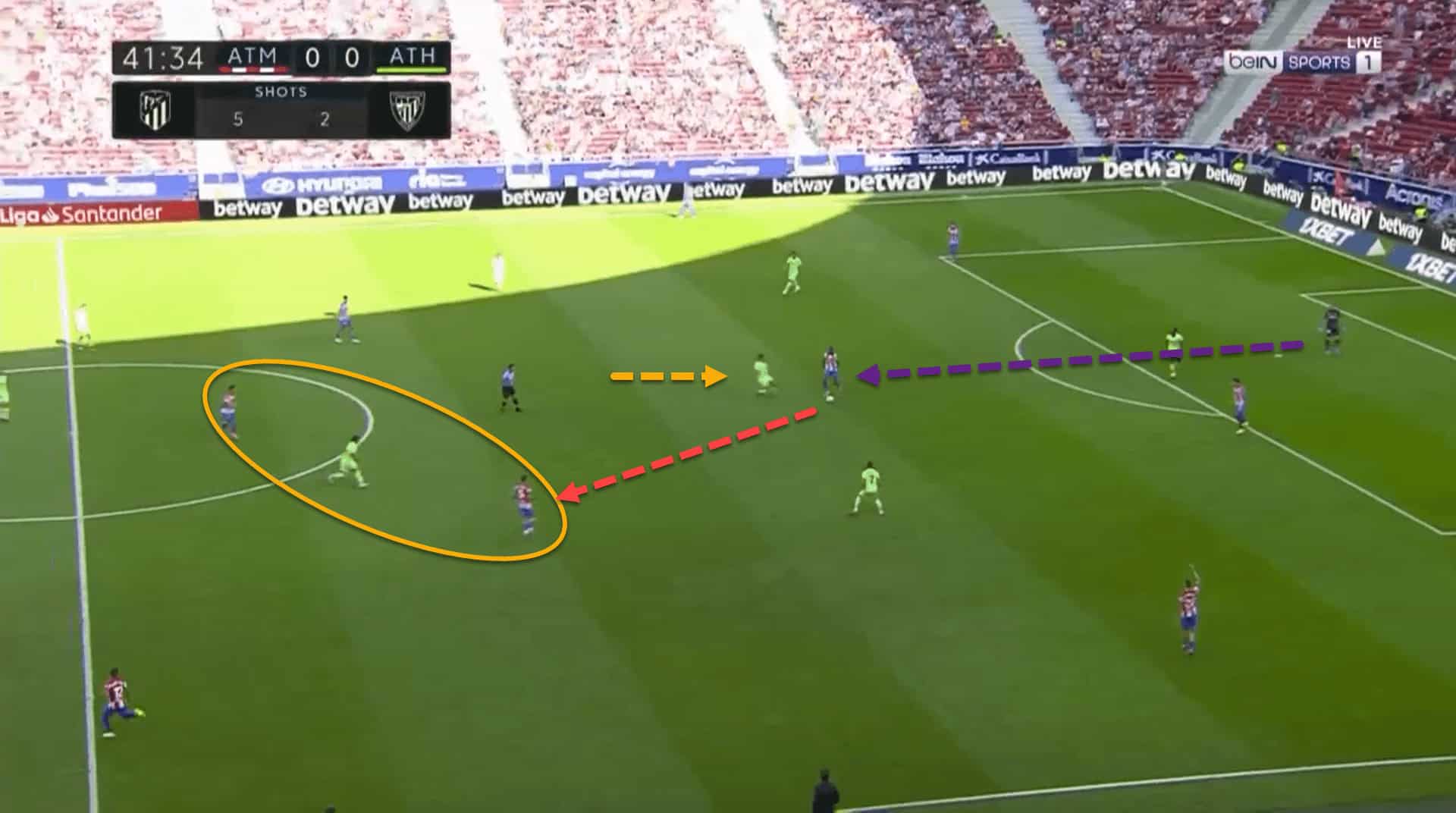
Here, Atlético’s goalkeeper has broken through the first line of pressure. The ball-near pivot player was slow to react to the midfielder receiving the ball and so the furthest defensive midfielder is in a 2v1 situation against two players in his zone.
This allows for easy ball progression for La Liga’s 2021 champions and shows how high-risk Athletic Club’s press can be — high risk, high reward for Marcelino’s men. The Basque side have scored 3 goals this season from pressing sequences — the joint-second highest in La Liga so far this season.
Managing the depth of the defensive line
One of the most important attributes for a team that press high is how well they manage the last line of their defensive block.
The backline must step up at the right time and ensure that the space between themselves and the midfield is squished in order to squeeze the opponent as best as possible and “make the pitch small”, to quote the legendary Dutch player and coach, Johan Cruyff. Athletic Club excel in this aspect which is a credit to the brilliant work on the training ground of Marcelino and his coaching staff.
There are triggers to pushing up the defensive line. The main one is when the opposition make a backwards pass. Quite often in a pressing trap, it may not be possible to cause a turnover, but it will at least force a back pass from the ball-carrier.
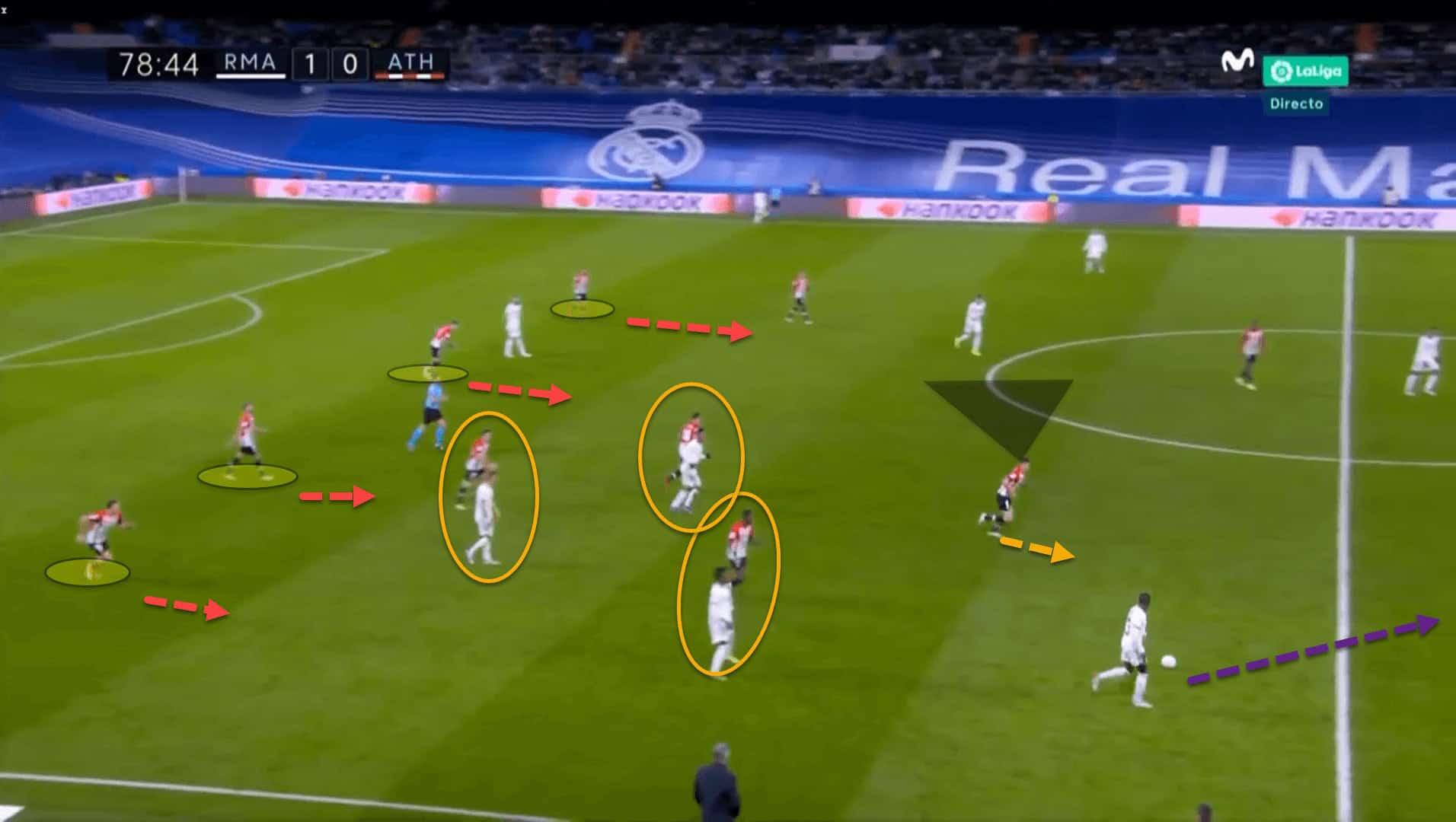
In this example from a recent game against Real Madrid, Athletic Club have successfully marked all inside and forward passing lanes which forces the ball-carrier to play backwards.
What is noticeable about the image is the body shape of the backline. They have oriented their body to be read to push up and squeeze the space as quickly as possible. The backline leads this pressing trigger, but the midfield and forward line follow suit.
The team pushes up as a unit when the opposition passes backwards in order to ensure that the new ball-receiver has limited passing options ahead of him or space to play it into. This will generally force another backwards pass when applied correctly.
‘Keep the opponent away from our goal as much as possible’ is the message from the manager. The further the opponent are away from the goal, the less damage they can inflict.
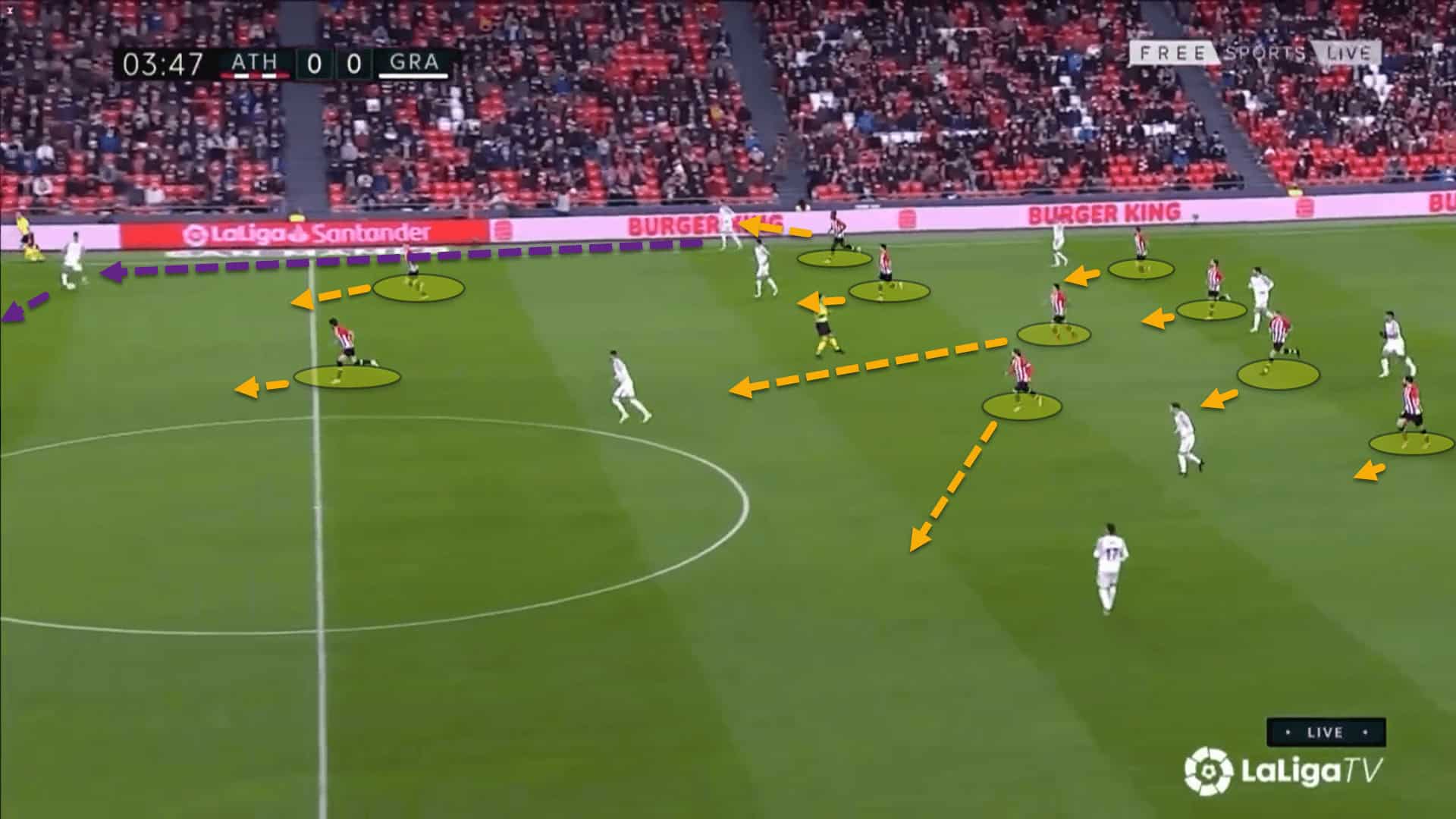
Again here, Athletic Club have forced two backwards passes in a row and are able to push their entire defensive block up straight away, closer to the opposition’s goal and apply a high press.
They mark any ball-near passing lanes too to prevent the ball-carrier from finding a progressive passing option straight away.
Managing the depth of the backline and pushing up as a unit is so vital for a team that press high, and Marcelino’s side have it down to a tee.
Conclusion
Athletic Club struggle in certain phases of the game but pressing high isn’t one. Marcelino has drilled this side extremely well and the Basque club are a wonderful case study for any coach, analyst, or even just a casual viewer who wants to expand their knowledge of how to successfully apply a high block.
Each player understands their role, and the players work in unison, constantly communicating with each other to ensure that their press is fully functional. It is not always perfect but is a wonderful asset for the side to prevent goals at one end and turnover possession at the other which could lead to a goal.






Comments